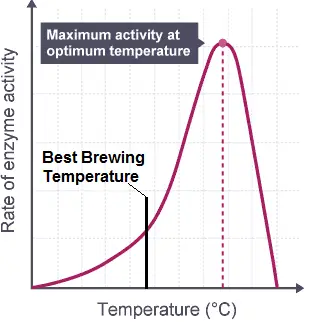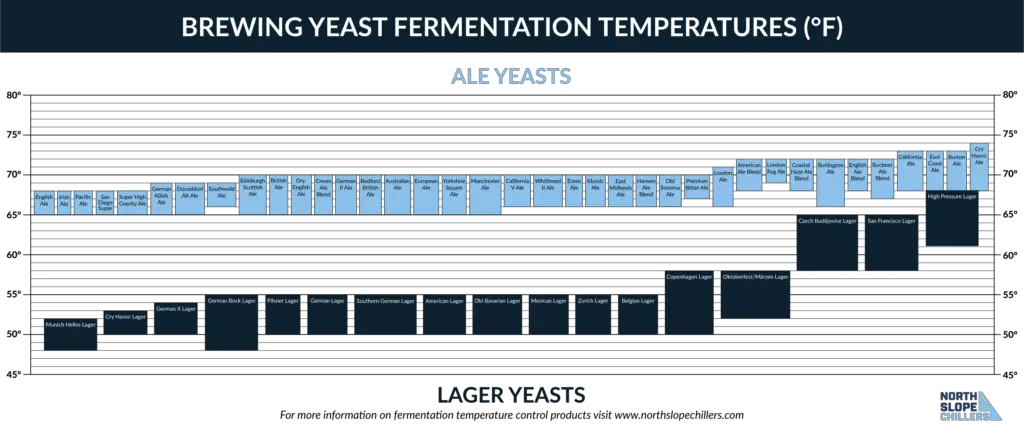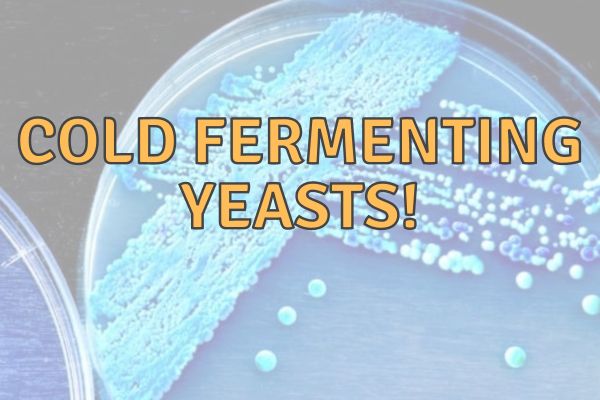Yeast is a critical ingredient in brewing, playing a crucial role in the fermentation process. Different yeast strains yield different flavors, aromas, and alcohol content in the final brew.
Today, we’re going to look at low-temperature yeast strains, which are perfect for cold fermentation.
So, what are some good low-temperature yeast strains? The top low-temperature yeast strains include Saflager W-34/70, Saflager S-23, Fermentis SafAle US-05, and Lallemand Nottingham Ale Yeast, among others.
Here are 5 good cold fermenting yeast strains:
| Yeast Strain | Origin | Type | Optimal Temperature Range (°F) | Optimal Temperature Range (°C) | Description |
|---|---|---|---|---|---|
| Saflager W-34/70 | Germany | Lager | 48-59 | 9-15 | Known as the world’s most utilized lager strain, famous for its clean and well-balanced lagers. |
| Saflager S-23 | Germany | Lager | 48-59 | 9-15 | Developed and used by large breweries, known for creating fruity and estery lagers. |
| Fermentis SafAle US-05 | USA | Ale | 53.6-77 | 12-25 | An American ale yeast known for its versatility and ability to produce a wide range of beers. |
| Lallemand Nottingham Ale Yeast | UK | Ale | 57.2-70 | 14-21 | A high-performance yeast strain known for its wide fermentation temperature range and neutral flavor profile. |
| Lallemand Diamond Lager Yeast | Germany | Lager | 50-59 | 10-15 | A true lager strain originating from Germany, known for producing traditional European lagers with a clean, crisp flavor profile. |
1. Saflager W-34/70
Unveiling the World’s Most Popular Lager Yeast
Originating from Germany, the Saflager W-34/70 yeast strain is known as the world’s most utilized lager strain. It’s a reliable choice for brewing at low temperatures, typically between 48-59°F (9-15°C).

This yeast strain is famous for its clean and well-balanced lagers. With its ability to produce subtle flavors and maintain a mellow profile, the Saflager W-34/70 is an excellent choice for brewing traditional Pilsners and other lagers.
2. Saflager S-23
A Versatile Lager Yeast
Developed and used by large breweries, the Saflager S-23 yeast strain is another excellent choice for those interested in cold fermentation. It works best at temperatures between 48-59°F (9-15°C).

This yeast strain is known for creating fruity and estery lagers, particularly when fermented at the upper end of its temperature range. If you’re looking to create a unique, flavor-packed lager, the Saflager S-23 could be the right choice.
3. Fermentis SafAle US-05
The Cool Ale Yeast
Fermentis SafAle US-05 is an American ale yeast known for its versatility and ability to produce a wide range of beers. It can ferment at low temperatures, around 53.6-77°F (12-25°C) – which is quite low for a top fermenting yeast!

Fermentis SafAle US-05 produces well-balanced beers with low diacetyl and a clean, crisp finish. It’s a great choice for brewers aiming for consistency and reliability in their cold fermentation process.
4. Lallemand Nottingham Ale Yeast
A High-Performance Ale Yeast
The Lallemand Nottingham Ale Yeast is a high-performance yeast strain known for its wide fermentation temperature range. It can ferment between 57.2-70°F (14-21°C), making it a perfect choice for low-temperature ale brewing.

This yeast strain is versatile, suitable for a variety of beer styles due to its neutral flavor and aroma profile. It also has a high alcohol tolerance, making it ideal for brewing high-gravity beers.
5. Lallemand Diamond Lager Yeast
A fifth strain that I would suggest is the Lallemand Diamond Lager Yeast.

This yeast strain is a true lager strain originating from Germany. It can ferment at low temperatures, typically between 50-59°F (10-15°C), and is known for producing traditional European lagers with a clean, crisp flavor profile.
Understanding Yeast Optimal Temperatures
Yeast, being a living microorganism, operates within a specific temperature range where it functions at its best.
However, when it comes to brewing, the optimal temperature for yeast growth doesn’t always align with the best conditions for brewing excellence.

Temperature has a profound impact on yeast activity, influencing the fermentation rate and the flavor profile of the resulting product.
Yeast’s role in brewing is pivotal, as it converts sugars into alcohol and carbon dioxide, ultimately contributing to the rich array of flavors and aromas that define beer.
What’s important to note is that the temperature ideal for yeast growth isn’t necessarily the ideal temperature for brewing.
The temperature at which yeast functions plays a critical role in shaping the final characteristics of the brew, emphasizing the nuanced relationship between yeast, temperature, and the art of brewing.
Cold Fermentation: A Brief Overview
Cold fermentation is a brewing technique that involves fermenting beer at lower temperatures than traditional ale or lager fermentations.
This method has gained popularity in recent years due to its ability to produce clean, crisp, and refreshing beers with unique flavor profiles.
Cold fermenting yeasts are specifically chosen for their ability to thrive in these lower temperature conditions.
Optimal Temperature Ranges
Cold fermenting yeasts, often referred to as “cold-tolerant” strains, exhibit their best performance within a specific temperature range.
While this range can vary between yeast strains, it typically falls between 45°F to 60°F (7°C to 15°C). These temperatures are notably lower than the ranges typically associated with ale and lager fermentations.
Benefits of Cold Fermentation Temperatures
Cold fermentation offers several benefits, including cleaner flavors, reduced risk of off-flavors, and increased yeast health. It also allows for better lager production, as lager yeast strains perform best at colder temperatures.
- Reduced Esters and Phenols: Cold fermentation minimizes the production of esters and phenols, compounds responsible for fruity and spicy flavors and aromas. This results in a cleaner and crisper beer profile, allowing the malt and hops to shine through.
- Enhanced Flocculation: Cold-tolerant yeasts tend to flocculate (settle) more readily at lower temperatures. This aids in achieving a clearer and brighter beer, reducing the need for extended conditioning periods.
- Extended Fermentation Window: Cold fermentation slows down yeast metabolism, which can be advantageous for certain beer styles. It provides brewers with a more extended fermentation window, allowing for precise control over the final product.
- Yeast Stress Reduction: Lower temperatures reduce the likelihood of yeast stress and off-flavor production, resulting in a smoother and more harmonious beer.
Challenges of Cold Fermentation
While cold fermentation offers several advantages, it is not without its challenges:
- Extended Fermentation Times: Cold fermentation generally requires more time to complete compared to warmer fermentations. Patience is key when employing this technique.
- Temperature Control: Maintaining consistent temperatures within the specified range can be challenging, particularly for homebrewers. Investing in temperature-controlled equipment may be necessary.
- Yeast Selection: Choosing the right cold-tolerant yeast strain is critical. Research and experimentation are essential to find the strain that complements your desired beer style.
Ale and lager yeasts: The highs and lows of fermentation temperatures!
Ale and lager yeast are two distinct strains of yeast commonly used in the brewing industry to produce different types of beer.

They differ not only in terms of the flavors they impart but also in their optimal fermentation temperatures and the reasons behind these differences.
Ale Yeasts:
- Ale yeast, most being Saccharomyces cerevisiae, is a top-fermenting yeast strain. It ferments at warmer temperatures compared to lager yeast.
- Optimal fermentation temperature for ale yeast typically ranges from 60°F to 75°F (15°C to 24°C). Some ale yeast strains may even tolerate slightly higher temperatures.
- The warmer fermentation temperatures associated with ale yeast lead to a faster fermentation process. This results in a beer with a quicker turnaround time, often ready to drink in a matter of weeks.
- Ale yeast produces a wider range of flavors and aromas, including fruity esters and spicy phenols, which contribute to the complex and diverse flavor profiles found in ales. These flavors are often more pronounced due to the higher fermentation temperatures.
Lager Yeasts:
- Lager yeast, scientifically known as Saccharomyces pastorianus, is a bottom-fermenting yeast strain. It ferments at cooler temperatures compared to ale yeast.
- Optimal fermentation temperature for lager yeast typically ranges from 45°F to 55°F (7°C to 13°C). Some lager yeast strains may require even cooler temperatures, especially for traditional lager styles.
- The colder fermentation temperatures associated with lager yeast result in a slower fermentation process. Lager beers often require a longer maturation period, sometimes several months, to reach their optimal flavor.
- Lager yeast produces fewer esters and phenols compared to ale yeast. This results in a cleaner and crisper flavor profile with a focus on malt and hops characteristics. Lager beers are known for their subtlety and balance.
Why the Temperature Difference?
- The primary reason for the difference in optimal fermentation temperatures between ale and lager yeast lies in their evolutionary history and adaptation.
- Ale yeast strains have developed to thrive in warmer temperatures, as they were historically used in regions with milder climates. Their ability to ferment at higher temperatures allows for a quicker brewing process.
- Lager yeast strains, on the other hand, have adapted to cooler temperatures, often found in regions with cold winters and caves. Their slow, cool fermentation process contributes to the clean and crisp profile of lager beers.
- Temperature also influences the production of fermentation byproducts. Ale yeast, fermenting at warmer temperatures, generates more esters and phenols, while lager yeast, fermenting at cooler temperatures, minimizes these compounds.
In summary, ale and lager yeast are two distinct types of yeast with different optimal fermentation temperatures and flavor profiles.
These differences are rooted in their evolutionary history and adaptation to specific environmental conditions.

Brewers carefully select the yeast strain and fermentation temperature to achieve the desired characteristics in their beer, whether it’s a fruity and complex ale or a clean and crisp lager.
This makes them ideal for brewing in warmer climates or during the summer months when control over temperature might be challenging.
Conclusion
Understanding yeast optimal temperatures is fundamental when cold fermenting for brewing. Cold fermentation offers unique benefits, such as reduced ester and phenol production, enhanced flocculation, and an extended fermentation window.
However, it also presents challenges in terms of time and temperature control. By carefully selecting the appropriate yeast strain and monitoring fermentation conditions, brewers can harness the power of cold fermentation to craft exceptional beers with distinct and appealing characteristics.
In conclusion, the best low-temperature yeast strains include Saflager W-34/70, Saflager S-23, Fermentis SafAle US-05, and Lallemand Nottingham Ale Yeast. Each of these yeast strains has unique characteristics that make them ideal for cold fermentations.
Here are the top 10 facts about low-temperature yeast strains:
1. Saflager W-34/70 is the most popular lager yeast in the world.
2. Saflager S-23 is used by large breweries and is known for producing fruity and estery lagers.
3. Fermentis SafAle US-05 is a versatile American ale yeast that produces well-balanced beers.
4. Lallemand Nottingham Ale Yeast has a high alcohol tolerance and a broad fermentation temperature range.
5. Low-temperature yeast strains are ideal for cold fermentation.
6. Cold fermentation offers cleaner flavors and reduced risk of off-flavors.
7. Cold fermentation increases yeast health.
8. Lager yeast strains perform best at colder temperatures.
9. Different yeast strains yield different flavors, aromas, and alcohol content.
10. Yeast plays a critical role in the brewing process.
From my personal experience as a brewer, I’ve found that these low-temperature yeast strains not only produce excellent beers but also offer a unique brewing experience. By experimenting with these strains, you can bring out the best in your brew and create something truly remarkable. Happy brewing!
FAQs
What is the best yeast for low temperature fermentation?
The best yeast for low temperature fermentation is generally lager yeast. It is known for its ability to thrive in cooler temperatures, typically around 45-55°F (7-13°C). Lager yeast produces clean and crisp flavors, making it ideal for brewing lagers and other cold-fermented beers.
What temperature is too cold for beer fermentation?
The temperature that is too cold for beer fermentation is typically below 50 degrees Fahrenheit (10 degrees Celsius).
What is the best yeast for cold weather?
The best yeast for cold weather is typically a lager strain. It is known for its ability to perform well in colder temperatures, allowing for proper fermentation during chilly conditions.
What is the best yeast for no temp control?
The best yeast for fermentation without temperature control would be a strain that can tolerate a wide range of temperatures e.g. the Lalvin Ec-118.
What is too cold to pitch yeast?
The temperature at which it is too cold to pitch yeast is when it falls below the recommended range for yeast activation and fermentation.
What is the lowest temperature for ale yeast?
The lowest temperature that ale yeast can typically tolerate is around 50 degrees Fahrenheit (10 degrees Celsius).




